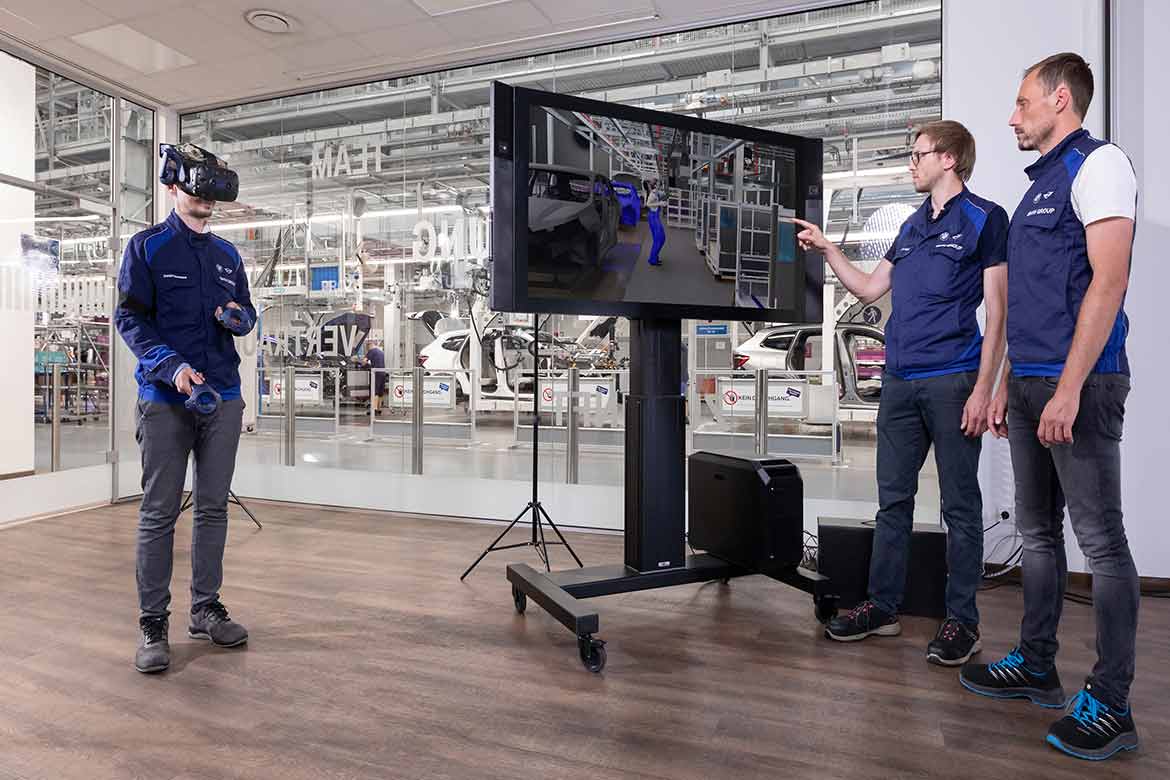2024 年 7 月 18 日
+++数字化工厂布局已能真实模拟未来运营+++员工使用VR眼镜接受“数字孪生”培训+++
+++数字化工厂布局已能真实模拟未来运营+++员工使用VR眼镜接受“数字孪生”培训+++
雷根斯堡。 在宝马集团雷根斯堡工厂,已经可以以虚拟形式体验几年后的工厂面貌:宝马下一代车型 NEUE KLASSE 的产量也将在 2020 年下半年在雷根斯堡增加。工厂总监 Armin Ebner 表示:“凭借基于全新车辆架构的 NEUE KLASSE,我们公司的目标是为数字化、电气化和循环性树立新标准。今天,在正式启动批量生产的许多年前,新生产线的虚拟规划已经在顺利进行中——即使我们仍在继续生产当前的 BMW X1 和 BMW X2 车型。”
系列发布前几年的新生产线虚拟图像
作为在汽车装配中实施的试点项目的一部分,雷根斯堡宝马集团首次在全公司范围内使用“3D 人体模拟”。雷根斯堡生产系统创新和数字化专家 Sebastian Moser 解释说:“这不仅使我们能够在数字孪生中虚拟映射未来的制造结构,还可以模拟未来在我们装配线上工作的员工。”实际上,这意味着可以在新车型系列发布之前很久就虚拟映射和测试雷根斯堡装配线上的未来工作流程和单个操作。
“该项目是迈向数字化和智能互联 BMW iFACTORY 的又一步,”Ebner 确认道。“虚拟化、人工智能和数据科学正在加速和完善我们的规划。数字化工厂规划使我们能够减少规划工作量,并在未来实现更高效、更稳定的汽车发布。” BMW 集团采用数字优先的方法来验证和优化整个生产网络中的复杂制造系统,依靠 NVIDIA Omniverse Enterprise(一个用于创建和运行 3D 工业元宇宙应用程序的平台)来运行数字孪生模拟。
人体模拟已经非常接近未来工厂的现实
到目前为止,宝马集团雷根斯堡工厂的“3D 人体模拟”涵盖了一条完整的生产线,包含 41 个操作周期,覆盖了超过 1,000 平方米的装配空间。未来工厂布局中的操作真实模拟使人们能够制定有效的周期规范并进行有益于健康的人体工程学分析。
“我们数字装配线上的‘模型人’就像真人一样移动和行动,”雷根斯堡工厂的汽车装配生产和质量专家 Dominik Wottke 解释道。“例如,如果软件检测到虚拟员工需要弯得太低或举起太重的重物才能完成操作,那么现实世界中也是如此。因此,我们能够有针对性地对此做出反应,并改进建模。”
VR 眼镜带领员工踏上虚拟未来之旅
“3D 人体模拟”还可用作培训和信息工具。“我们可以利用数字孪生的视频序列带领我们的员工踏上未来之旅,向他们展示未来的工作场所将会是什么样子,”沃特克说。项目经理为此设立了一个虚拟房间,雷根斯堡汽车装配厂的员工可以戴上 VR 眼镜,虚拟探索未来的装配线,并在必要时近距离检查细节。他们还可以与虚拟“同事”一起工作,练习特定的操作周期并提高技能。目的是提前培训这些操作,从而缩短实际装配线上的学习阶段。
宝马集团雷根斯堡和瓦克斯多夫工厂
数十年来,宝马集团一直将自己视为汽车制造生产技术和卓越运营的标杆,包括其位于雷根斯堡和瓦克斯多夫的工厂。
宝马集团雷根斯堡汽车厂自 1986 年开始运营,是宝马集团全球 30 多个生产基地之一。每个工作日,雷根斯堡工厂共生产出多达 1,400 辆 BMW X1 和 BMW X2 车型,销往世界各地的客户。不同类型的传动系统在一条生产线上灵活生产,从内燃机汽车到插电式混合动力汽车,再到全电动车型。
雷根斯堡生产的电动车型的高压电池也在当地生产,就在汽车工厂附近。它们在 2021 年在莱布尼茨大街工厂开业的电动元件生产工厂组装。
瓦克斯多夫宝马创新园也属于雷根斯堡基地。这座占地 55 公顷的园区建于 20 世纪 80 年代,最初旨在作为核再处理设施。宝马集团将其驾驶舱生产以及其海外工厂的零部件供应设在这里。除了宝马作为最大的雇主外,其他几家公司也位于瓦克斯多夫创新园。共有约 2,500 名员工在那里工作。
位于巴伐利亚东部雷根斯堡和瓦克斯多夫工厂的宝马集团核心员工约有 9,250 名,其中包括 300 多名学徒。
www.bmwgroup-werke.com/regensburg/de.html
Innovative “3D human simulation”: BMW Group Plant Regensburg uses virtual tools to plan assembly processes years ahead of NEUE KLASSE series launch
18.07.2024
+++ Realistic simulations of future operations already possible in digital factory layout +++ Employees trained on “digital twin” using VR goggles +++
+++ Realistic simulations of future operations already possible in digital factory layout +++ Employees trained on “digital twin” using VR goggles +++
Regensburg. At BMW Group Plant Regensburg, it is already possible to experience in virtual form what the factory will look like a few years from now: Production of the NEUE KLASSE, BMW’s next model generation, will also ramp up in Regensburg in the second half of the decade. Plant Director Armin Ebner: “With the NEUE KLASSE, which is based on an entirely new vehicle architecture, our goal as a company is to set new standards for digitalisation, electrification and circularity. Today, many years before the official launch of series production, virtual planning of the new production lines is already well underway – even as we continue to build the current BMW X1 and BMW X2 models.”
Virtual image of new production lines years before series launch
As part of a pilot project implemented in vehicle assembly, BMW Group Regensburg is utilising “3D human simulation” for the first time company-wide. “This allows us to not only map future manufacturing structures virtually in a digital twin, but also simulate the employees who will work on our assembly lines in the future,” explains Sebastian Moser, an innovation and digitalisation specialist for the Regensburg production system. In practice, this means future workflows and individual operations on the Regensburg assembly line can be virtually mapped and tested long before the series launch of new models.
“The project is a further step towards the digital and intelligently connected BMW iFACTORY,” confirms Ebner. “Virtualisation, artificial intelligence and data science are accelerating and refining our planning. Digital factory planning enables us to reduce planning effort and realise more efficient, stable vehicle launches in the future.” The BMW Group is adopting a digital-first approach to validate and optimise complex manufacturing systems throughout its production network, relying on NVIDIA Omniverse Enterprise, a platform for creating and operating 3D industrial metaverse applications, to run simulations with digital twins.
Human simulation already very close to future factory reality
To date, the “3D human simulation” at the BMW Group site in Regensburg encompasses a complete line section with 41 operating cycles, covering over 1,000 square metres of assembly space. Realistic simulation of operations in the future factory layout makes it possible to already develop effective cycle specifications and conduct health-friendly ergonomic analyses today.
“The ‘model people’ on our digital assembly line move and behave just like real people,” explains Dominik Wottke, a production and quality expert in vehicle assembly at the Regensburg plant. “For example, if the software detects that a virtual employee needs to bend too low or lift a weight that is too heavy to be able to complete an operation, then that is also the case in the real world. We are therefore able to respond to this in a targeted manner and make improvements in the modelling.”
VR goggles take employees on virtual journey into the future
The “3D human simulation” also serves as a training and information tool. “We can use video sequences from the digital twin to take our associates on a journey into the future and show them what their future workplace will look like,” says Wottke. Project managers have set up a virtual room for this purpose, where employees from vehicle assembly in Regensburg can wear VR goggles to explore the future assembly line virtually and examine details up close, if needed. They can also practice specific operating cycles and enhance their skills, working alongside virtual “colleagues”. The aim is to train these operations so well in advance that the learning phase on the actual assembly line can be shortened.
BMW Group Plants Regensburg and Wackersdorf
The BMW Group has viewed itself for decades as the benchmark for production technology and operational excellence in vehicle construction – including at its locations in Regensburg and Wackersdorf.
The BMW Group vehicle plant in Regensburg has been in operation since 1986 and is one of more than 30 BMW Group production locations worldwide. A total of up to 1,400 vehicles of the BMW X1 and BMW X2 models come off the production line at Plant Regensburg every workday – destined for customers all over the world. Different types of drive trains are flexibly manufactured on a single production line – from vehicles with internal combustion engines to plug-in hybrids, to fully-electric models.
High-voltage batteries for the electric models built in Regensburg are also produced locally, in direct proximity to the vehicle plant. They are assembled at the electric component production facility, which opened in 2021 at the Leibnizstrasse location.
BMW Innovation Park Wackersdorf also belongs to the Regensburg site. The 55-hectare campus built in the 1980s was originally intended as a nuclear reprocessing facility. The BMW Group has located its cockpit production there, as well as its parts supply for overseas plants. In addition to BMW as the largest employer, several other companies are also based at Innovation Park Wackersdorf. A total of around 2,500 employees work there.
The BMW Group core staff at the Regensburg and Wackersdorf locations in eastern Bavaria is made up of around 9,250 employees, including more than 300 apprentices.
www.bmwgroup-werke.com/regensburg/de.html

